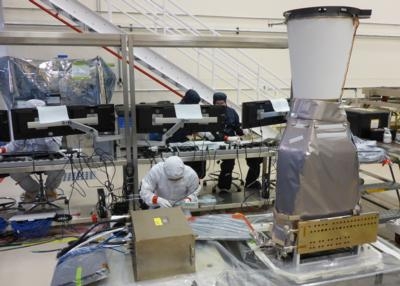Thu, Jan 14, 2016
Most Of The Western Hemisphere To Benefit From Better Severe Weather Warning
The second Geostationary Lightning Mapper (GLM) instrument that will provide earlier alerts of severe storms and contribute to more accurate tornado warnings has been delivered by Lockheed Martin. The sensor will fly on the second next-generation Geostationary Operational Environmental Satellite, known as GOES-S, for the National Oceanic and Atmospheric Administration (NOAA).

The Lockheed Martin team successfully completed assembly, integration, test and delivery of the second GLM instrument only 13 months after the first delivery.
"We reduced the build and test time of this complex instrument by 40 percent compared to the first unit," said Jeff Vanden Beukel, Lockheed Martin GLM program director. "Now that development is complete, we are able to reduce delivery time so the GOES program can serve our nation with more accurate weather information."
A rapid increase of in-cloud lightning can precede severe weather on the ground. GLM tracks that activity and gives faster warning plus more precise location information versus current systems. It does this by tracking lightning flashes from geostationary orbit, with continuous coverage of the United States and most of the Western Hemisphere. The heart of the GLM instrument is a high-speed (500 frames per second), 1.8 megapixel focal plane, integrated with low-noise electronics and specialized optics to detect weak lightning signals, even against bright, sunlit cloud backgrounds. It was developed at Lockheed Martin's Advanced Technology Center in Palo Alto.
GOES satellites are a key element in NOAA's National Weather Service operations, providing a continuous stream of weather imagery and sounding data used to support weather forecasting, severe-storm tracking and meteorological research. The GOES program is managed and operated by NOAA, and NASA's Goddard Space Flight Center manages GLM instrument development. The team is preparing GLM for integration on the GOES-S spacecraft at Lockheed Martin's facility near Denver.
(Image provided with Lockheed Martin news release)
More News
Airplane Bounced About 3 Ft Then Touched Back Down And Then, With No Brakes Applied, The Airplane Began Veering To The Left Analysis: The pilot entered the airport traffic pattern >[...]
Aero Linx: British Microlight Aircraft Association (BMAA) The primary focus within all aviation activity is SAFETY. In all aspects of our sport SAFETY must come first, whether it b>[...]
From SnF25 (YouTube Edition): William Wynne Builds Practical Aircraft Engines on the Corvair Platform Seeking an affordable alternative to the traditional aircraft engine options, >[...]
How To Get A Story On Aero-TV News/Feature Programming How do I submit a story idea or lead to Aero-TV? If you would like to submit a story idea or lead, please contact Jim Campbel>[...]
From 2023 (YouTube Edition): Bridge of CiES CiES Inc. is a Bend, Oregon-based designer and manufacturer of modular embedded aircraft systems and sensors. The company’s fuel-l>[...]
 NTSB Final Report: Aviat A1
NTSB Final Report: Aviat A1 ANN's Daily Aero-Linx (07.08.25)
ANN's Daily Aero-Linx (07.08.25) Classic Aero-TV: Fly Corvairs Reliable Engine Alternative
Classic Aero-TV: Fly Corvairs Reliable Engine Alternative ANN FAQ: Contributing To Aero-TV
ANN FAQ: Contributing To Aero-TV Classic Aero-TV: CiES Fuel-Quantity and e-Throttle Systems Praised
Classic Aero-TV: CiES Fuel-Quantity and e-Throttle Systems Praised



